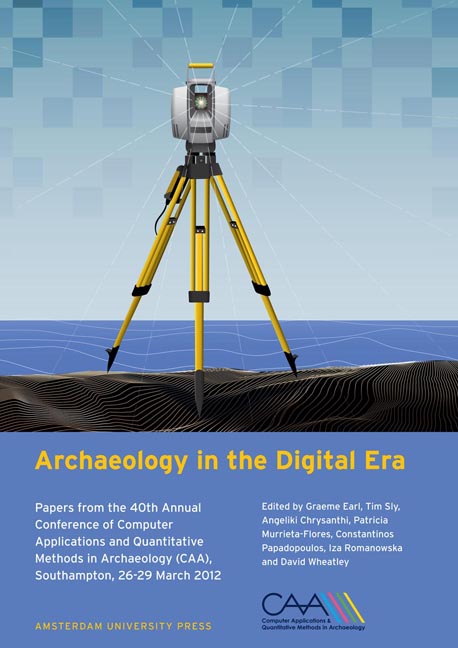 Archaeology in the Digital Era
Archaeology in the Digital Era Process Formalization and Conceptual Modelling in the Study of Territorial Dynamics
Published online by Cambridge University Press: 16 February 2021
Summary
Abstract:
The ArchaeDyn team has investigated territorial dynamics by comparing areas over long time spans between the Neolithic and Modern times. Datasets on various themes have been shared and indicators and analytical models produced. This paper presents both the formalization of scientific process used in the ArchaeDyn programme and a conceptual model of the systems and components so that synchronic and diachronic comparisons can be made. The aim is to clarify the transition from an archaeological feature (a site or an artefact) or a recording unit (survey area) as the input, to the characterization of spaces describing a system as the output. The approach is described by the successive steps corresponding to semantic, spatial or temporal analytical processes from the prospecting level to the level of complex objects such as the territories and spaces under study. These complex objects— consumption areas, agricultural areas and settlement patterns—are the subsystems in the dynamics of human territorial occupation. The main contribution of this formalization is that it describes synthetically the hypotheses tested and the approach implemented. In addition, it provides a collective validation of the research team's reasoning.
Keywords:
Models, Formalization, Analytical Process, Agricultural Areas, Settlement Patterns, Consumption Areas
Introduction
This paper is the outcome of collaboration as part of the ArchaeDyn programme funded by France's ANR (ANR-08-BLAN-0157) (Gandini et al. 2012). The ArchaeDyn programme was launched in 2004 to study territorial dynamics from Neolithic to Modern times. The programme is conducted by three workgroups focusing on separate themes: (i) the movement of raw materials and manufactured objects, (ii) agricultural areas; (iii) settlement patterns and territories.
All three workgroups exploit archaeological inventories collated as part of other scientific programmes. The ArchaeDyn members have implemented an analytical approach for sharingthese datasets and producing indicators and analytical models with which to compare geographical spaces over large time spans (Gandini et al. 2012; Poirier and Tolle 2008).
The sheer diversity of analysis produced in the eight years the programme has been running (for the same purpose of describing and comparing different ‘pieces of space’ occupied by humans) means that, although the analytical methods are properly applied, the process is not always clear at each stage.
- Type
- Chapter
- Information
- Archaeology in the Digital EraPapers from the 40th Annual Conference of Computer Applications and Quantitative Methods in Archaeology (CAA), Southampton, 26-29 March 2012, pp. 438 - 448Publisher: Amsterdam University PressPrint publication year: 2014


